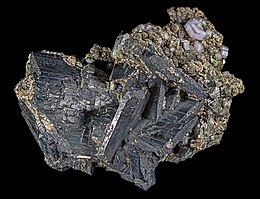Wolframite
| Wolframite | |
|---|---|
 | |
| General | |
| Category | Oxide minerals |
| Formula (repeating unit) | (Fe,Mn)WO4 |
| Crystal system | Monoclinic |
| Crystal class | Prismatic (2/m) (same H-M symbol) |
| Space group | P2/c |
| Unit cell | a = 4.77 Å, b = 5.73 Å c = 4.98 Å; β = 90.2°; Z = 2 |
| Identification | |
| Color | Grayish to brownish black |
| Crystal habit | Tabular to short prismatic crystals |
| Cleavage | Perfect 010 |
| Fracture | Uneven to rough |
| Mohs scale hardness | 4-4.5 |
| Luster | Submetallic to resinous |
| Streak | Reddish brown |
| Diaphaneity | Opaque |
| Specific gravity | 7 - 7.5 |
| Pleochroism | None |
| Fusibility | 3 - 4 to magnetic globule |
| Solubility | insoluble |
| References | [1][2][3] |
Wolframite is an iron, manganese, and tungstate mineral with a chemical formula of (Fe,Mn)WO4 that is the intermediate between ferberite (Fe2+ rich) and hübnerite (Mn2+ rich). Along with scheelite, the wolframite series are the most important tungsten ore minerals. Wolframite is found in quartz veins and pegmatites associated with granitic intrusives. Associated minerals include cassiterite, scheelite, bismuth, quartz, pyrite, galena, sphalerite, and arsenopyrite.
This mineral was historically found in Europe in Bohemia, Saxony, and Cornwall. China reportedly has the world's largest supply of tungsten ore with about 60%. Other producers are Canada, Portugal, Russia, Australia, Thailand, South Korea, Rwanda, Bolivia, the United States, and the Democratic Republic of the Congo.[4]
Name[]
The name "wolframite" is derived from German "wolf rahm", the name given to tungsten by Johan Gottschalk Wallerius in 1747. This, in turn, derives from "Lupi spuma", the name Georg Agricola used for the element in 1546, which translates into English as "wolf's froth" or "cream". The etymology is not entirely certain but seems to be a reference to the large amounts of tin consumed by the mineral during its extraction, the phenomenon being likened to a wolf eating a sheep.[5] Wolfram is the basis for the chemical symbol W for tungsten as a chemical element.
Use[]

Wolframite is highly valued as the main source of the metal tungsten, a strong and very dense material with a high melting temperature used for electric filaments and armor-piercing ammunition, as well as hard tungsten carbide machine tools. During World War II, wolframite mines were a strategic asset, due to its use in munitions and tools.[6]
Wolframite was considered to be a conflict mineral due to the unethical mining practices observed in the Democratic Republic of the Congo, during the Congo Wars.[7]
See also[]
References[]
| Look up wolframite in Wiktionary, the free dictionary. |
- ^ Barthelmy, Dave. "Wolframite Mineral Data". webmineral.com.
- ^ "Wolframite: Wolframite mineral information and data". www.mindat.org.
- ^ Klein, Cornelis and Cornelius S. Hurlbut, Jr., Manual of Mineralogy, Wiley, 20th ed. 1985, pp. 355-356 ISBN 0-471-80580-7
- ^ "Clean them up". The Economist. 19 August 2010.
- ^ van der Krogt, Peter. "Wolframium Wolfram Tungsten". Elementymology & Elements Multidict. Retrieved 2010-03-11.
- ^ "Nazi Gold: Spain and Portugal". 2011-08-19. Archived from the original on 2011-08-19. Retrieved 2017-11-11.
- ^ "Clean them up: Congo's conflict minerals". The Economist. Vol. 396, no. 8696. 21 August 2010. p. 41. Retrieved 24 August 2010.
| Wikimedia Commons has media related to Wolframite. |
- Tungsten minerals
- Manganese(II) minerals
- Iron(II) minerals
- Tungstate minerals
- Monoclinic minerals
- Minerals in space group 13